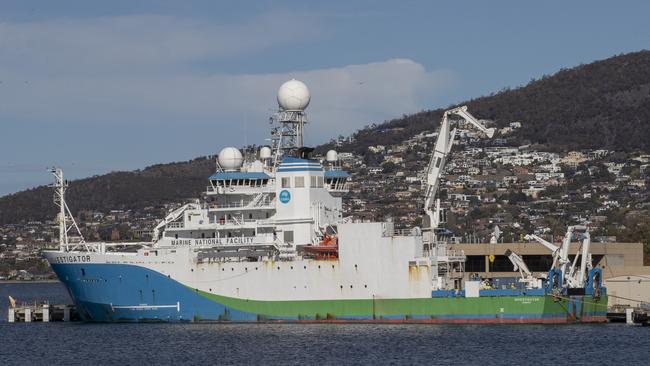CSIRO’s RV Investigator uses AI trained cameras to count seabirds on upcoming science voyage
Scientists aboard the RV Investigator will harness the power of groundbreaking technology in an upcoming voyage, including an artificial intelligence trained camera to count seabirds. Details >>

Tasmania
Don't miss out on the headlines from Tasmania. Followed categories will be added to My News.
With the power of artificial intelligence and DNA, a team of scientists will use groundbreaking technology to uncover the mysteries of Australia’s oceans.
CSIRO’s research vessel the Investigator will leave Hobart on Wednesday with scientists and crew to travel up to the South East coast of Australia in a month-long voyage.
This voyage will be using technology including an AI trained camera which can count seabirds passing the ship.
While voyage chief scientist Dr Richard Little said he’s feeling nervous about being seasick, he’s excited to be a part of this huge endeavour.
“In the last voyage last July, we mounted cameras all around the ship to collect footage of seabirds,” he said.
“We collected all the data and then a team in Sydney actually labelled the data and drew boxes around all the birds on all the videos so like five terabytes of data.
“Then they train this model and put together this camera that they’re mounted on the ship which will be counting sea birds.
“They’re integrating it into the ship system so that it’ll write a report of the bird count and then send the email to shore once a day.”

While one of the objectives of the mission is to test the new AI, a team of scientists will also use a new technique which will capture DNA in the water.
“There’s a contraption called the CTD which goes down into the water and there’s about 36 bottles which collects water at certain depths,” Field technician and Environmental DNA (EDNA) specialist Dr Sahan Jayasinghe said.
“We can look at the water and see what sort of biodiversity or the distribution of animals. We’re looking at mainly fishes and potentially we’re going to expand it later to look at the smaller microbes like zooplankton and phytoplankton.
“We’re collecting EDNA using three different methods on this voyage. We’re going to compare between those methods and also compare against the traditional surveying methods of patrolling and cameras.
“What’s unique about this is that most people will do just EDNA surveys, and just look at what the biodiversity is, but we can match it up with the actual biomass numbers that we’re getting from the traditional survey so we can connect multiple parts of the picture together, whereas other people will just have one single part to look at.”

Two pakana people from Flinders Island will also be joining the voyage as a sea country ranger.
“They both actually have small little projects that are going on the voyage with fauna that are culturally important to their community,” Dr Little said.
“We’ll be going on to a range of sea country areas off Victoria, New South Wales but we start our sampling in Freycinet and then go as North as Merimbula, off the coast of Gippsland into the oil and gas area.”
Dr Little said the Investigator will be visiting the same places sampled 30 years ago in the 1990s.
“To have that long term sight time series into the same locations is really important,” he said.
“We did an experiment last year in Freycinet Marine Park where we ran a camera over the bottom and we dragged the trawl mats over the bottom and then we took a picture over the bottom again to see what the damage was.
“This coming week, we will drive a camera over it again to see what the recovery was and we’ll be doing this again to see how fast the recovery is of disturbances from something like fishing.”
More Coverage
Originally published as CSIRO’s RV Investigator uses AI trained cameras to count seabirds on upcoming science voyage




